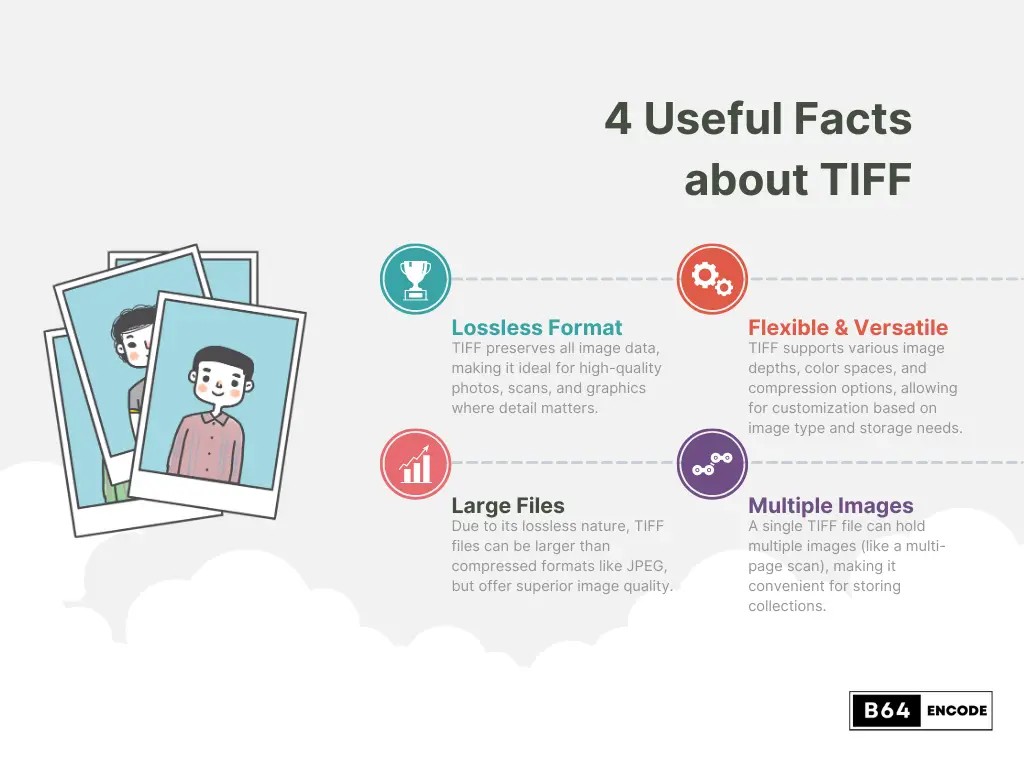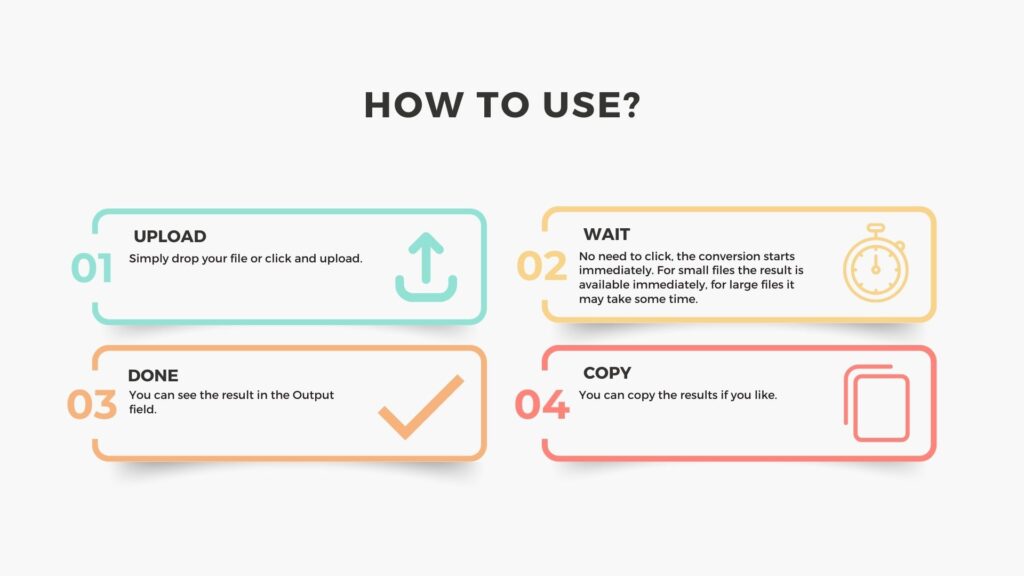Transform your TIFF/TIF images into Base64 format seamlessly using our TIFF to Base64 Encoder. Whether you’re handling high-quality images or need to integrate this functionality into your projects, our tool ensures efficient TIFF-to-Base64 encoding. Say goodbye to file format complexities and embrace the simplicity of our converter.
TIFF to Base64 Converter
Upload an Image
Settings
What is Base64?
Base64 is a widely employed encoding technique that transforms binary data into ASCII characters, enhancing the efficiency of data transfer and storage processes. By representing binary information in a text-based format, Base64 ensures compatibility across various systems and platforms. This method is particularly valuable in scenarios where traditional binary data might encounter issues, providing a standardized approach for transmitting and storing data in a more universally accessible manner.
What is Base64 Encoding?
In general, encoding is the process of transforming data from one format to another. Base64 encoding is achieved by representing binary data with a set of 64 different ASCII characters. This encoding becomes especially beneficial in situations where there is a necessity to transfer data between systems that lack inherent support for binary data.
How Does Base64 Encoding Work?
Base64 encoding is a widely-used method for transforming binary data into a text-based representation, enabling reliable transmission and storage across various platforms. At its core, Base64 encoding relies on a simple yet effective principle. It first divides binary data into 6-bit chunks and then translates each chunk into the corresponding ASCII characters, resulting in a human-readable, albeit difficult to interpret, format. This text-based representation can be easily sent, received, and stored without the risk of data corruption or loss, making Base64 encoding an essential tool for numerous applications.
What is TIFF/TIF?
TIFF (Tagged Image File Format), sometimes known as TIF, is a popular file format for storing high-quality raster pictures. Because of its capacity to preserve picture integrity, it is frequently employed in professional photography and graphic design.

What is a TIFF to Base64 Converter?
When working with images, it’s often useful to represent them as text strings for seamless integration with various platforms and systems. A TIFF to Base64 converter is a handy tool that transforms TIFF images into a text-based format, enabling easier embedding and sharing.
By converting TIFF images to Base64-encoded files, you can easily embed them in web pages, emails, and other platforms that support text-based data, ensuring consistent and reliable display across different systems. This convenient tool streamlines the conversion process, allowing you to quickly and efficiently transform your TIFF images into a versatile, text-based representation.
How Do I Use the Online TIFF to Base64 Encoder?
- First, upload your TIF image.
- No need to press a button, just wait until the encoding is complete. For large files, this may take longer.
- You can copy the result using the Copy button.

How Does the TIFF to Base64 Converter Work?
The TIFF to Base64 Converter uses the Base64 encoding algorithm to convert a TIF image file into a string of characters. This encoded string represents the binary data of the TIF image, allowing images to be stored and shared as text.
Why would I need to convert a TIFF image to Base64?
When there is a desire to seamlessly integrate TIFF images into HTML or CSS code, eliminating the requirement for standalone image files, leveraging Base64 conversion proves valuable. This approach not only streamlines the web development process but also offers practicality in scenarios where direct image embedding is preferred. Additionally, the utility of converting images to Base64 extends to sharing visuals within text-based environments, such as emails or databases, ensuring efficient data transfer and storage while maintaining the visual integrity of the images.
Is it Secure to Use Your TIFF to Base64 Converter?
Certainly. Our application functions exclusively within your browser, conducting all conversion processes on the client side. This approach guarantees that no data is transmitted to external servers, safeguarding the confidentiality and control of your information throughout the entire conversion process.
Base64 Characters
Capital letters (A-Z), lowercase letters (a-z), numbers (0-9), and two extra characters, commonly “+” and “/”, constitute the group of 64 ASCII characters employed in Base64 encoding. In instances where the binary data length isn’t a multiple of three bytes, padding is introduced using the “=” character.
| Value | Character | Binary Value |
|---|---|---|
| 0 | A | 000000 |
| 1 | B | 000001 |
| 2 | C | 000010 |
| 3 | D | 000011 |
| 4 | E | 000100 |
| 5 | F | 000101 |
| 6 | G | 000110 |
| 7 | H | 000111 |
| 8 | I | 001000 |
| 9 | J | 001001 |
| 10 | K | 001010 |
| 11 | L | 001011 |
| 12 | M | 001100 |
| 13 | N | 001101 |
| 14 | O | 001110 |
| 15 | P | 001111 |
| 16 | Q | 010000 |
| 17 | R | 010001 |
| 18 | S | 010010 |
| 19 | T | 010011 |
| 20 | U | 010100 |
| 21 | V | 010101 |
| 22 | W | 010110 |
| 23 | X | 010111 |
| 24 | Y | 011000 |
| 25 | Z | 011001 |
| 26 | a | 011010 |
| 27 | b | 011011 |
| 28 | c | 011100 |
| 29 | d | 011101 |
| 30 | e | 011110 |
| 31 | f | 011111 |
| 32 | g | 100000 |
| 33 | h | 100001 |
| 34 | i | 100010 |
| 35 | j | 100011 |
| 36 | k | 100100 |
| 37 | l | 100101 |
| 38 | m | 100110 |
| 39 | n | 100111 |
| 40 | o | 101000 |
| 41 | p | 101001 |
| 42 | q | 101010 |
| 43 | r | 101011 |
| 44 | s | 101100 |
| 45 | t | 101101 |
| 46 | u | 101110 |
| 47 | v | 101111 |
| 48 | w | 110000 |
| 49 | x | 110001 |
| 50 | y | 110010 |
| 51 | z | 110011 |
| 52 | 0 | 110100 |
| 53 | 1 | 110101 |
| 54 | 2 | 110110 |
| 55 | 3 | 110111 |
| 56 | 4 | 111000 |
| 57 | 5 | 111001 |
| 58 | 6 | 111010 |
| 59 | 7 | 111011 |
| 60 | 8 | 111100 |
| 61 | 9 | 111101 |
| 62 | + | 111110 |
| 63 | / | 111111 |







